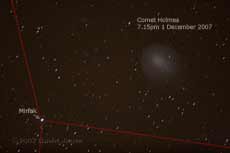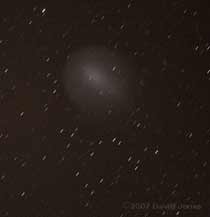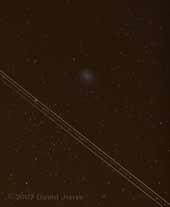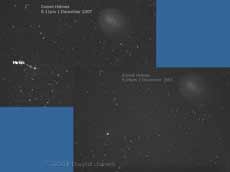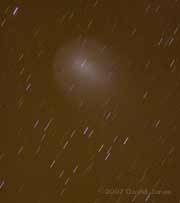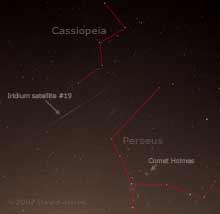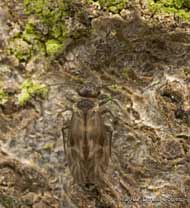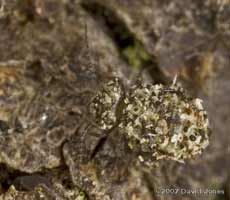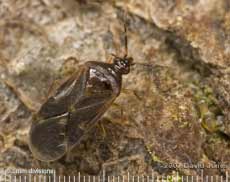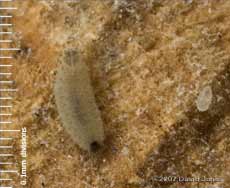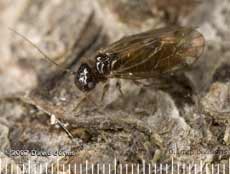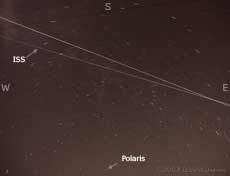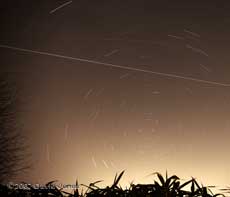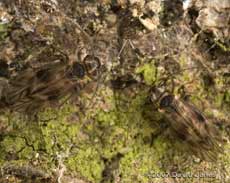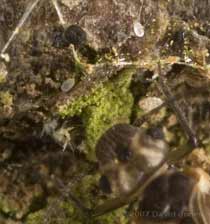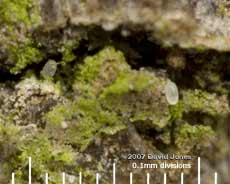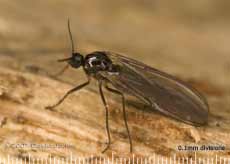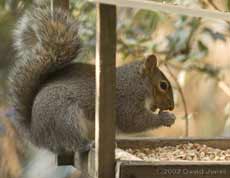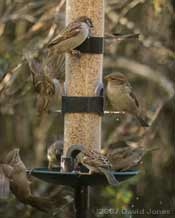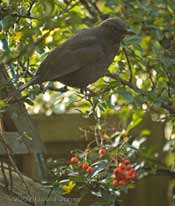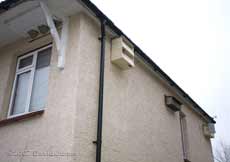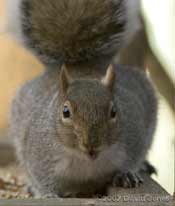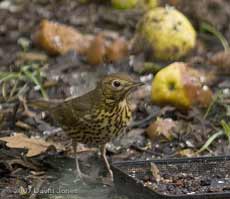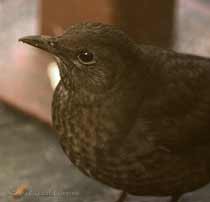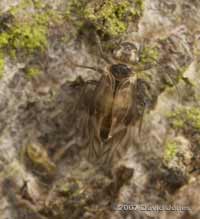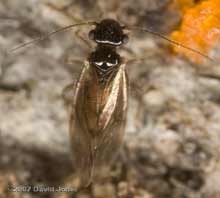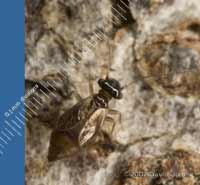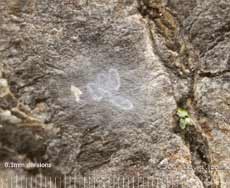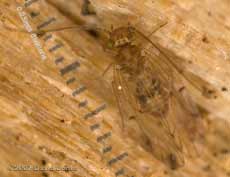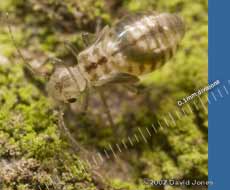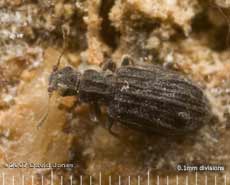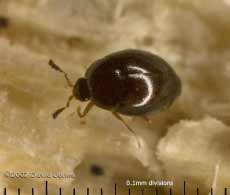Go to the last entry on this page ... ....Go to previous entry! December - After last night's wind and rain today has been a bright and largely sunny start to the new month.
For me it was a day for doing
very little, but after dark I noticed that the sky was particularly clear so
I set up my camera to try to get a few more Comet Holmes pictures.
For this picture, taken at around 7.15pm, the stars are seen as streaks because I kept the shutter open for 14 seconds with the lens aperture at f/4. The comet was at about 45° elevation and east north-east of us.
This is a cropped version of the same picture, and you can see how the tail of the comet points towards the bottom-right of the image.
One problem with having a telephoto lens on the camera is that you haven't a hope of catching that unexpected meteorite that streaks across the sky. This happened when one appeared somewhere slightly north of the Perseus constellation and travelled west south-west across the sky, remaining visible for what must have been an arc of at least 30°.
Fortunately, these aircraft were too low to leave a vapour trail that could have interrupted my view of the comet.
I have just been back outside at 10.15pm, and because of the rotation of the earth, Perseus and the comet are now directly overhead.
2 December - A horrible, wet and windy morning gave way to sunshine in the afternoon and clear skies in the evening.
Tonight the comet was almost due east of us and close to an elevation of 70°.
The morning's rain and high winds seem to have helped to create good visibility tonight, but it is still not possible to avoid the orange glow of street lighting. In the first two images I removed the colour completely, but I have left it in this long, 30 second exposure. Aside from the comet, it is interesting to note the variation on colour amongst the stars.
3 December - A bright and sunny day with a high temperature of just over 9C but with a chilly north wind making it feel colder. While it stayed dry here, this afternoon I could see a heavy rain shower passing to the south of us. I didn't mention it at the time, but a week ago we finally got round to getting a new carpet fitted in the lounge, where we had installed a log burner at the beginning of the year. We had to remove a partition door which needed trimming to go over the new carpet. Today the weather was perfect for me to get the modifications done outside, with the wind dealing with the sawdust. The partition is now back in place. That work did mean that I didn't have time to do any daytime photography today, but after dark I set up my tripod outside again to capture one of those interesting events in the skies over us. There is a network of some 66 low orbit communication satellites called Iridium that sometimes reflect sunshine by one of three highly reflective antennae to create what are known as Iridium flares. There are websites that predict when and where these can be seen. One such site can be seen here .
It's not a spectacular picture (I needed to be some 35km further east to see its full brightness) and I was nearly defeated by my neighbour who just happed to switch on his outside lighting just as I was about to open the camera shutter, which I kept open for a 50 second exposure.
Turning back to the garden, I think the hedgehogs have now decided that it is time to hibernate. I last saw a solitary hedgehog four nights ago, and despite night-time temperatures remaining above 5C I don't think the food has been touched for a couple of nights.
7 December - We have just had a mild spell. Yesterday the temperature hovered at just below 14C for most of the day and was still around 13C at midnight. It has also been quite wet, and last night was very windy. However, today has been bright, dry and calm, and this evening we have clear skies, although I have not been tempted to take more pictures of Holmes! Perhaps tempted out by the mild conditions, there was a small moth outside our kitchen window yesterday evening. Unfortunately it had left by the time I got outside with my camera.
The log pile at the bottom of the garden continues to provide a fertile hunting ground for barkflies, with both L. variegata and P. milleri (seen in this picture) still active.
As for their nymphs, it is those of L. variegata that are most evident, despite their attempts at camouflage, although they only become easy to see once they start moving. The unadorned P. milleri nymphs are actually harder to spot but are still present.
Back on the 4th October I photographed one of these bugs as it fed on a P. milleri nymph. Just like the barkflies, these bugs are still active (I saw several during the day but saw no sign of them tonight). This one passed very close to the nymph at the right of the picture, but apparently didn't detect it.
On the 27th November I photographed one of numerous tiny 'hairy' larvae that seemed to be browsing on what is probably mildew at the end of a log. These are still present, and today I also saw a number of plainer, and even smaller larvae feeding under the same circumstances.
At less than 2.5mm in length it is smaller than P. milleri (around 3mm) and L. variegata at over 4.5mm. I have looked at the National Barkfly recording site and my barkfly handbook and my first impressions are that it could be Ectopsocus axillaris, or a similar species. This ID has since been confirmed by Bob Saville. This morning we had eight Goldfinches at the feeders, the largest number for several weeks, and for s short time they were joined by a Greenfinch. A single Coal Tit has become a regular visitor to the table now, and the raisins that I put out for the Blackbirds are being devoured by them with great enthusiasm! This afternoon a Blue Tit was spending a lot of time calling from the Birch tree. It has me wondering if it is time to re-install a cctv camera in the Blue Tit box ready to monitor it over the Christmas period. I haven't photographed them but there has been one group of Primroses in flower for the last week. Sadly, the slugs have decided that they cannot resist a winter delicacy, so the flowers are in tatters!
13 December - Another gap! The colder weather has resulted in a couple of frosty nights with the air temperature dipping to near -3C last night, and the skies are clear again this evening.
This first image was an exposure of six and a half minutes, taken at around 5.30pm yesterday evening. The upper of the two tracks that cross the image from left (west) to right (east) was left by an aircraft as it made its preparations to land at Farnborough, flying over us at no more than 3000ft altitude. In contrast, the Space Station passed over us at an altitude of just under 200 miles!
The camera was pointing North, and up at an angle of 70°. The long exposure has recorded the apparent movement of the stars around the Pole Star (Polaris). It also shows the problem caused by Aldershot's town lighting - both Aldershot town centre and that of Farnborough lie almost directly north of us.
I photographed this pair and when I took a close look at the image I spotted what looked like eggs.
At first I wondered if they were mites, but I could see no signs of legs or other body structures. And what is that behind the barkfly's right-hand antenna?
However, I doubt that the eggs belong to these adults as seem far too small - The barkfly eggs that I have photographed have all been about 0.5mm long, and these are only just over 0.1mm in length.
Yesterday, with the temperature below 4C I was surprised when I turned over one of the logs to find two of these tiny flies mating. I couldn't get a photograph as they separated as soon as I disturbed them, but this is a photograph that I took a few days ago. The wing venation suggests that it could belong to the Mycetophilidae.
18 December - The weather has continued dry and cold since the last entry, with the temperature not rising above 4C over the last few days, although night-time temperatures have hardly dipped below freezing during that period. My attention has been on things other than the garden as we approach Christmas. There was a trip to North London on Monday (letting the train take the strain!), and yesterday we had a large load of seasoned logs delivered to guarantee supplies for the burner over the next couple of months. We stacked some of them yesterday, but today I'm suffering the consequences. The job must be finished before the weekend when it seems that milder, wet weather will return.
While part of me says that
these squirrels are in the same category of alien 'invaders' as the
Harlequin Ladybirds, I can't help but enjoy watching their antics when they
visit the garden. At the time, the garden was quite a busy place with birds almost queuing up to get to the feeders, the sparrows squabbling over access to the 'budgie food'. The sparrows have started having frequent bouts of squabbling. A couple of days ago I saw a female Sparrowhawk fly into the garden. Unusually, despite there being sparrows perched on top of the Hawthorn, it was a leisurely approach and she landed in my neighbour's Birch tree. She stayed for a couple of minutes, with the sparrows seemingly unconcerned, before she flew off again.
The Collared Doves (at least six) and a couple of Wood Pigeons seemed confused my the squirrel's antics and kept on flying up to perches each time it returned to the table. The Blue and Great Tits waited in the Hawthorn and the Buddleia until it left the table before they helped themselves. The Blackbirds are about nearly all the time now, and unless they are chasing each other you can usually spot one either down on the ground under the Hawthorn, or perched in the tree, or on the gate. Yesterday, one female remained perched on the gate for some twenty minutes while I moved about just yards from her as I cleared the area ready for the log delivery.
As well as eating the raisins that I put out for them, they are also working their way through what berries are left on the Pyracantha between the Hawthorn and the veranda. This female was having problems getting to the berries which are on a very thin branch. Frustration got the better of her in the end and she headed for the raisins.
The Goldfinches were absent during the Squirrel's visit, but earlier in the day I counted ten around the feeders. There were frequent sightings of Dunnocks during the day, not so many of a Robin, and a couple of Starlings. I haven't seen a Coal Tit here over the last few days, and there have been no sightings of Greenfinches since I last mentioned one on the 7th.
21 December - The last two days have stayed very cold. Yesterday we awoke to a touch of freezing fog and I don't think the temperature in the garden rose much above zero all day, at least until after dark when it actually rose by a couple of degrees. Today there was no morning frost and no sign of any mist, but the temperature still remained below 2C all day under grey skies. Today we reach the Winter Solstice and I can't wait to start noticing the days lengthening again! Yesterday's easterly wind eased today, and I took advantage of the dry conditions to do a job that was high on my 'things to do before next Spring' list. For anyone who followed my nesting diaries this year, the next image is a 'spot the difference' picture. As well as the failure of the House Martins' brood, another disappointment last Spring was the aggressive, territorial behaviour of the nesting Starlings towards the Swifts when the latter arrived to nest in my neighbour's roof space.
Today I moved the Starling
nest box (with two compartments), to as near as possible the back corner of
the house, moving the darker coloured House Sparrow terrace (4 compartments)
from that position to the spot previously occupied by the Starling box. I cleaned out the Starling nests, but left the Sparrowboxes untouched as they are in constant use. Hopefully, the move will provide enough space between Swifts and Starlings for both to get on with their nesting next Spring, with the Sparrows providing some sort of buffer between the two! Just in case, I am leaving in place the aluminium screen that I added in desperation during the 'troubles', and I will reinstall cameras in the Starling boxes in the new year.
29 December - First of all, a belated Season's Greetings. I hope your holiday went well, as did ours. I took the decision to keep computer use to a minimum over the Christmas holiday and concentrate on the family instead. Christmas day was mild and a bit damp. Since then, daytime temperatures have reached nearly 12C (on the 27th) and over 10C yesterday. Rain arrived yesterday afternoon, continuing into the night as temperatures dropped to 1C. Today has been dry and bright withy the temperature reaching just under 8C, although a keen north-westerly breeze made it feel colder. This morning I took the opportunity to remove the House Martin nest boxes and clean them. They will not go back up until I have checked out the cameras as there was a problem with one of them last Spring. That is another job for the new year.
The squirrel has been a regular visitor this week, usually coming in the late morning, although I haven't seen a repeat of the peanut burying that I saw on its first visit.
Going back to Christmas Eve, we had a very welcome visit from a Song Thrush which tucked into the currants that I had put out. I haven't seen it here since. A very slow shutter speed means a slightly shaky image. I also saw a rare visit by a Pied Wagtail. It was startled by a Collared Dove before I had a chance to photograph it. While they are common birds, I can only recall ever seeing one in the garden twice since 1975.
The Blackbirds continue to visit frequently, and the one female that I've mentioned before is becoming more and more trusting. While this picture was taken through a window, she seemed unflustered when I remained within a few feet of her on our veranda this morning. Things change quickly when a male blackbird turns up and chases after her!
There are still barkflies to be seen on the log that I have been concentrating my observations on these last few months.
This evening, with the temperature at 6C, I could see just one P. milleri adult although I could see several active nymphs.
I could also see one adult Ectopsocus axillaris (on Christmas Eve I saw five adults).
I also saw what appears to be a nymph of E. axillaris. If this is the case then it is the first time that I have seen a nymph of this species here. Correction - this is actually a short-winged form (brachypterous) of the adult - a common condition in this species (thanks to Bob Saville for that info). There are also nymphs of L. variegata still active, but I haven't seen any adults since the end of November.
I was surprised by the sight of an egg cluster on the log that I spend most time inspecting. I suspect that it must have been produced during the last three days as I check the log frequently, and it showed up clearly when I used my torch.
This adult Ectopsocus petersi that blended in well with the colour of the wood was spotted on another piece of wood on the 23rd. The egg cluster looks very much like those produced by this species, although I couldn't see any examples on the log today.
Just to make sure that we had a good time over the Christmas period, Sheila and I have both been hit by a flu bug, Sheila first, over Christmas itself, and me since yesterday, so it looks as though we will be coughing and spluttering our way into the new year!
31 December - A rather dull, dry end to the year with an overnight temperature of 5C creeping up to 7C by tonight. The flu kept me off my feet for much of the day, and it wasn't until after dark that I felt like doing much at all. However, I did take a brief look at the logs and came back with three pictures to compete this entry.
First, a nymph of P. milleri which was moving about quite quickly. I couldn't see any examples of E. axillaris, neither adult or nymph, but I did see a L. variegata nymph on the move.
Next, a couple of tiny beetles. This one appears to be a tiny wood boring beetle about 1.7mm in length, although I haven't a clue as to its ID. I'm not sure about the light coloured object on the right side of its thorax. It doesn't appear to be just debris, but I didn't get pictures from other angles that may have shown it more clearly.
The second beetle is about half the size, at 0.8mm. Tonight I could only see one, but two nights ago I saw four on the same cut surface of a log. It looks similar to, although a little bigger than a beetle I photographed on the same logs on 28 November.
Click on images to see larger versions |
|
